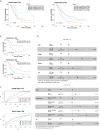An Eight-Gene Hypoxia Signature Predicts Survival in Pancreatic Cancer and Is Associated With an Immunosuppressed Tumor Microenvironment
- PMID: 34093582
- PMCID: PMC8173254
- DOI: 10.3389/fimmu.2021.680435
An Eight-Gene Hypoxia Signature Predicts Survival in Pancreatic Cancer and Is Associated With an Immunosuppressed Tumor Microenvironment
Abstract
Intratumoral hypoxia is a widely established element of the pancreatic tumor microenvironment (TME) promoting immune escape, tumor invasion, and progression, while contributing to treatment resistance and poor survival. Despite this critical role, hypoxia is underrepresented in molecular signatures of pancreatic ductal adenocarcinoma (PDA) and concurrent investigations into the hypoxia-immune status are lacking. In this work a literature-based approach was applied to derive an eight-gene hypoxia signature that was validated in fourteen cancer cell lines and in a cohort of PDA. The eight-gene hypoxia signature was significantly associated with overall survival in two distinct PDA datasets and showed independent prognostic value in multivariate analysis. Comparative analysis of tumors according to their hypoxia score (high versus low) determined that tumors with high hypoxia were significantly less enriched in cytotoxic T-cells, and cytolytic activity. In addition, they had lower expression of cytokines and tumor inflammatory markers, pointing to the signature's ability to discern an immune "cold", hypoxic TME. Combining the signature with an immune metric highlighted a worse survival probability in patients with high hypoxia and low immune reactivity, indicating that this approach could further refine survival estimates. Hypoxia as determined by our signature, was significantly associated with certain immune checkpoint inhibitors (ICI) biomarkers, suggesting that the signature reflects an aspect of the TME that is worth pursuing in future clinical trials. This is the first work of its kind in PDA, and our findings on the hypoxia-immune tumor contexture are not only relevant for ICI but could also guide combinatorial hypoxia-mediated therapeutic strategies in this cancer type.
Keywords: hypoxia; immunosuppresive; immunotharapy; microenvironment; pancreatic cancer; prognostic; signature; tumor inflammation.
Copyright © 2021 Abou Khouzam, Rao, Venkatesh, Zeinelabdin, Buart, Meylan, Nimmakayalu, Terry and Chouaib.
Conflict of interest statement
The authors declare that the research was conducted in the absence of any commercial or financial relationships that could be construed as a potential conflict of interest.
Figures






References
-
- Marabelle A, Le DT, Ascierto PA, Di Giacomo AM, De Jesus-Acosta A, Delord JP, et al. . Efficacy of Pembrolizumab in Patients With Noncolorectal High Microsatellite Instability/Mismatch Repair-Deficient Cancer: Results From the Phase Ii KEYNOTE-158 Study. J Clin Oncol (2020) 38(1):1–10. 10.1200/JCO.19.02105 - DOI - PMC - PubMed
Publication types
MeSH terms
Substances
LinkOut - more resources
Full Text Sources
Medical

